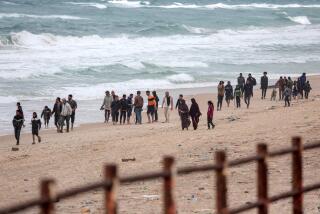Explosions rock Baghdad; militants post gruesome execution photos
- Share via
Reporting from Erbil, Iraq — Gruesome photos posted online Sunday by an Al Qaeda splinter group show the summary executions of dozens of captive Iraqi soldiers in the group’s attack on a city in central Iraq and are believed to be authentic, military officials have acknowledged.
The release of the photos by the Islamic State of Iraq and Syria, or ISIS, came amid violence elsewhere in Iraq. A string of explosions rocked Badghad on Sunday, killing at least 15, according to the Associated Press. Earlier in the day, Agence France-Presse reported that six people were killed when a recruitment center in central Iraq for volunteer fighters was hit by mortar rounds.
The purported execution photos are being widely shared on social media and Iraqi military officials acknowledged being aware that some of the soldiers had been killed by their captors. But the military did not provide a specific number, and there was no way to verify the militant group’s claims.
UPDATE: U.S. adds security to embassy in Baghdad, relocates some staff
The Iraqi military’s chief spokesman, Lt. Gen. Qassim Moussawi, told the Associated Press that the photos were believed to be real and confirmed that the dead soldiers had been taken prisoner by ISIS.
The crisis has made for some unlikely bedfellows. Iranian President Hassan Rouhani said Saturday that Iran would “consider” working with the United States to bolster the shaky Shiite-led Iraqi government, with which Iran has strong ties. He added that Prime Minister Nouri Maliki had not contacted Iran for assistance.
On Sunday, Sen. Lindsey Graham (R-S.C.), who serves on the Armed Services Committee, called for the U.S. to talk directly with Iran to devise a plan to stop what he characterized as an ISIS march toward Baghdad. “If ISIS is not dealt with, that’s the staging area for a new attack on the United States,” Graham said on CNN.
The killings of captive Iraqi soldiers were said to have taken place in the Iraqi province of Salahuddin and the environs of Tikrit, the birthplace of Saddam Hussein, about 90 miles northwest of the capital, Baghdad.
ISIS fighters last week launched a blitz in Mosul, Iraq’s second-largest city and an important oil hub, that saw Iraqi army and police units shed their uniforms and literally run for their lives. The government, stunned by the collapse of its forces, vowed swift and harsh punishment for those who abandoned their posts.
The online images purportedly document the attack on Tikrit, beginning with ISIS fighters atop pickup trucks and sedans raising their black banner at staging points outside Tikrit. Others show army Humvees and heavy trucks, originally provided by the U.S. to Iraq’s military, commandeered by the fighters.
More disturbing photos follow, depicting rows of men lying on the ground in shallow trenches as an ISIS fighter sprays them with gunfire. A caption boasts of “killing of the herds … that have escaped from the military bases.” Other images show what are described as captured soldiers in trucks to be “taken to their deaths” as “the lions of ISIS race to devour their prey.”
Many Sunnis view the Iraqi army as a force largely driven by the sectarian dictates of Maliki, a Shiite hardliner whose exclusionary policies have bred deep resentment among the Sunni population. Shiites are the majority in Iraq but Sunnis are a large minority and previously held most posts of power.
Bulos is a special correspondent. Times staff writer Laura King contributed to this report from Cairo.
More to Read
Sign up for Essential California
The most important California stories and recommendations in your inbox every morning.
You may occasionally receive promotional content from the Los Angeles Times.














